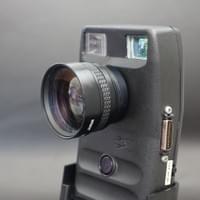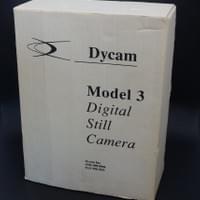
Dycam Model 1 (1990)
Take a very close look. Here is something we didn't notice at the time. It’s the world’s first consumer digital camera.
If we lived in America, Europe or Australia in 1990, this was our first opportunity for digital photography*.
What a pity that very few of us handed over your US$995, £650 or equivalent. What an amazing story we could now be telling your grandchildren.
We shouldn't blame ourselves for failing to buy this camera, because the Dycam Model 1 didn't exactly shine. It produced only black and white photos of 376 x 240 pixel resolution using its tiny 1/3 inch, 0.09 megapixel sensor. It stored up to 32 images in compressed format on its 1MB of internal flash memory. The images had to be promptly downloaded onto a computer before they were lost from memory when the battery went flat. To take photos in sunny situations, a neutral density filter had to be attached. There was no monitor to view photos or even a display of the camera’s settings. There was only one button – the shutter button – but the camera communicated via a set of beeps. In order to know what it was communicating, there was a little interpretation card. For example, a high-pitch long beep followed by a low-pitch long beep means the memory is full. A high-pitch short beep, then a low-pitch short beep, then a high-pitch short beep means you have room for three more images in memory.
What could you do with such limited technology? What about printing the photos? Except, at their original resolution on a 300dpi printer of the era, the photos measured just 3/4 inch by 11/4 inches (2cm x 3cm). Of course, the idea was to use and manipulate them on a computer and subsequently on a website. Helpfully, the worldwide web was invented the year before and Photoshop V1.0 the same year.
Because of its limitations, Dycam achieved limited sales of the Model 1. A version licensed to the more market-savvy company Logitech did rather better.
You don't have to take all this on my say-so. Here is a remarkable CNN news item from 1992.
* In Japan only, Fujix released the DS-X digital camera the year before, and King Jim launched its DaVinci DV55 about the same time as Dycam launched its Model 1.
Dycam Model 3 (1992)
From the earliest years of the digital photography era, the 1992 Dycam Model 3 followed the pioneering Model 1.
At just 0.18 megapixels, its sensor had double the resolution. After you pressed the shutter, it required 10 seconds to store the image in its 1mb internal memory. Oh, and the image was still in black and white.
But looking back over three decades, the Dycam Model 3 is still a pioneering achievement. The Model 3 was sold with a system which generates colour images.
Now that you've seen the Model 1 and Model 3, here is the potted history of the whole Dycam series of cameras. Model 1 appeared in 1990 with a 0.09 megapixel monochrome sensor and 1mb of internal storage, enough for 32 photographs. There was no Model 2. Model 3 came out in 1992, as did the 3XL variant which had internal memory of 4mb. Model 4 appeared in 1993. Its internal memory was 1mb but it had a colour CCD sensor. The 4XL variant appeared at the same time with 4mb of internal memory.
Dycam 10-C (1995)
Three years after bringing out its upright Model 3, the Dycam company joined the pile-on for binocular-shaped cameras.
The DC-10 came on the market in 1995. It’s visually identical to the Kodak DC50 Zoom which arrived the following year – except the body of the DC-10 is an attractive light grey with cyan writing, while the DC50 is a conventional black.
The camera has nice features including a zoom lens, 0.4 megapixel sensor and PC card external storage. But there was no LCD screen and the price was close on US$1,000. That was a lot of money at the time.
David Leith © 2025




























